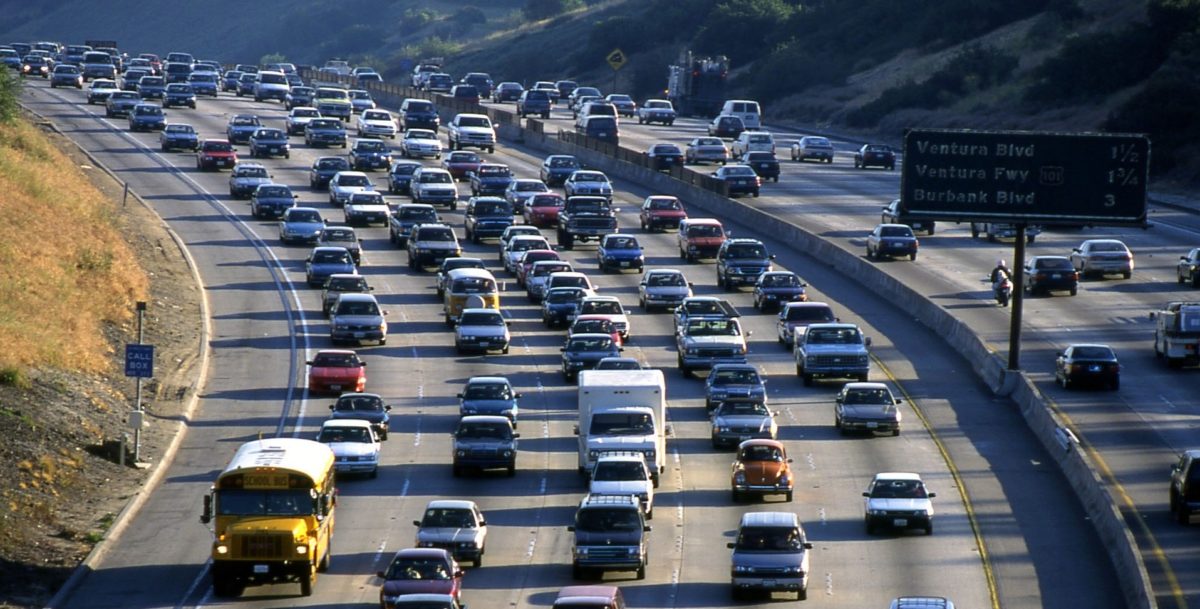 The Union of Concerned Scientists (UCS) quantified Californians’ exposure to dangerous air pollution and found that particulate matter disproportionately affects Californians of color and low-income communities. The following blog post about the findings, by David Reichmuth, Senior Engineer with the UCS Clean Vehicles program, is reprinted here with permission. Another blog post on the findings, by Maria Cecilia Pinto de Moura, also a Senior Engineer with the Clean Vehicles program, can be found here, in Spanish.
The Union of Concerned Scientists (UCS) quantified Californians’ exposure to dangerous air pollution and found that particulate matter disproportionately affects Californians of color and low-income communities. The following blog post about the findings, by David Reichmuth, Senior Engineer with the UCS Clean Vehicles program, is reprinted here with permission. Another blog post on the findings, by Maria Cecilia Pinto de Moura, also a Senior Engineer with the Clean Vehicles program, can be found here, in Spanish.
Cars, trucks, and buses are a significant source of air pollution in California. But how much pollution is attributable to these vehicles and who is exposed to this pollution? To help answer these questions, I’ve used a computer model to estimate the amount of fine particulate matter air pollution (known as PM2.5) created by using on-road vehicles (cars, trucks, and buses). The findings are troubling, both because they show that people of color are exposed to higher levels of harmful air pollution and because this result is likely not to be a surprise to many Californians (full report available in English and Spanish). The study supports the claims many have been making for decades – that on average, African American, Latino, and Asian Californians are exposed to more PM2.5pollution from cars, trucks, and buses than white Californians. In fact, these groups are exposed to PM2.5 pollution 43, 39, and 21 percent higher, respectively, than white Californians.
What is PM2.5 and why is it important?
Exposure to PM2.5 (particulate matter smaller than 2.5 micrometers in diameter) is linked to increased illness and death, primarily from heart and lung diseases. These particles are small —20 times smaller than the diameter of fine human hair— so they can penetrate deeply into the lungs, and the smallest particles can even enter into the bloodstream. While PM2.5 is not the only air pollutant that adversely affects health, it is estimated to be responsible for approximately 95 percent of the global public health impacts from air pollution. Long-term exposure to PM2.5causes increased death rates attributed to cardiovascular diseases, including heart attacks, and has been linked to other adverse impacts such as lung cancer. Chronic exposure to PM2.5 in children has also been linked to slowed lung-function growth, development of asthma, and other negative health impacts.
On-road vehicles like cars, trucks, and buses are a significant source of harmful emissions in California. The burning of fossil fuels such as gasoline and diesel has multiple negative effects: it produces climate-changing emissions such as carbon dioxide and pollution that reduces air quality. PM2.5 pollution is of particular concern in California, as the state has seven of the 10 most polluted US cities in terms of PM2.5 pollution.
Greater PM2.5 pollution for Latinos and African Americans, low-income households
We estimated exposure to particulate matter air pollution using a recently developed model from the University of Washington and data from the US Census Bureau. This model lets us calculate how vehicle tailpipe and refueling emissions ultimately lead to ground-level pollution exposure so we can understand how exposure to PM2.5 varies among groups and locations.
The results are clear: PM2.5 pollution burden from cars, trucks, and buses is inequitable when looking at the exposure experienced by racial groups in California. Latinos are, on average, exposed to 15 percent higher PM2.5 concentrations than the average Californian, and African Americans in California experience concentrations 18 percent higher than average. White Californians have average exposure that is 17 percent lower than the average for the state. This means that, on average, African American and Latino Californians are exposed to PM2.5 pollution that is 43 and 39 percent higher, respectively, than white Californians.

African American and Latino Californians are exposed to higher than average levels of particulate matter pollution from cars, trucks, and buses
Unequal pollution burdens can also be seen at the community level. In census tracts with average annual PM2.5 concentrations less than half the state average, whites make up 48 percent of the population, while only constituting 38 percent of the state’s total population. In contrast, the most polluted census tracts have a higher proportion of people of color. More than 60 percent of people in these highest burden areas are Latino, compared with a state population that is just 39 percent Latino. The inequities and disparities are clear.

Communities with higher percentages of white population have less exposure to particulate matter from cars, trucks, and buses.
Our research also links inequitable disparities in household income to pollution exposure, with less affluent households having higher exposure to PM2.5 pollution from on-road transportation. On average, households with the lowest incomes (less than $20,000 per year) are exposed to more than 25 percent more particulate matter air pollution than the highest-income households (greater than $200,000 per year).
PM2.5 exposure from cars and trucks varies greatly within California
Los Angeles County has the highest average PM2.5pollution exposure from cars and trucks in the state: on average, 60 percent higher than the mean value for the state. One quarter of the population in Los Angeles County experiences pollution levels that are more than double the state average. And because Los Angeles County is the most populous in the state, this higher level of pollution affects millions of people. Only six counties have an average exposure from on-road transportation that is greater than the state average, but four of them (Los Angeles, Orange, San Bernardino, and San Diego) are in the top five most populous counties in California, with a combined population of almost 19 million people.
Other areas, such as the San Francisco Bay Area, have zones of higher pollution but have much lower average exposure to vehicle-related particulate pollution compared with the state average. The worst regions of the Bay Area (such as downtown Oakland and San Jose) have annual average PM2.5concentrations equal to the average across Los Angeles County.
Click here to view an interactive map of the data.
Opportunities to reduce harmful impacts of vehicle use
Particulate matter air pollution from on-road transportation places significant health burdens on Californians, and those burdens are inequitably distributed. However, there are opportunities to greatly reduce the exposure to PM2.5 by reducing tailpipe and refueling emissions, making much of this burden avoidable.
Electrification of vehicles, both passenger and freight, could greatly reduce emissions. Battery-electric and hydrogen fuel cell vehicles in particular have no tailpipe emissions (however, there are minor amounts of PM2.5 emissions from tire and brake wear that all vehicles produce) and completely avoid the need for, and emissions associated with, gasoline refueling. Electricity generation and hydrogen production can produce emissions; however, California has renewable content standards for both hydrogen for transportation and electricity that will limit additional emissions.
While Californians can make a difference by buying cleaner vehicles, much of the pollution comes from sources outside an individual’s direct control, like heavy-duty trucks and buses. The state needs to continue to move forward on regulations, incentives, and other policies to reduce vehicle emissions. Equity and meaningful involvement of disadvantaged communities should be key considerations in designing policies and strategies to reduce pollution from vehicles. The state will need to continue to make progress on reducing emissions and should prioritize actions that reduce the inequitably distributed burden of air pollution in California. Programs like the Enhanced Fleet Modernization Program (incentives to help retire older, polluting cars) and low-income clean vehicle rebates are examples of ways the state can help, but clearly more can and should be done to address the problem of harmful air pollution in California.
